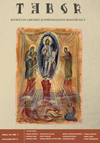Fecioara chemată la „nunta” Marelui Mire – Făt Frumos din lacrimă
The Virgin Invited to the “Wedding” of the Great Bridegroom - Prince Charming, the tear-begotten (Făt Frumos din lacrimă)
Author(s): Camelia SuruianuSubject(s): Language and Literature Studies
Published by: Renaşterea Cluj
Keywords: Mihai Eminescu, fairy tale, queen, pious attitude, Christian interpretation
Summary/Abstract: Many of the writings of Mihai Eminescu can be interpreted from the perspective of sacred symbolism. This article analyses some symbols in the fairy tale Prince Charming, the tear-begotten (Făt Frumos din lacrimă). At fi rst glance, one may notice that the writer uses a well-known traditional formula, often seen in fairy tales, as the text features certain typical characters: the king, the queen, Ileana and prince charming. Yet, there are scenes somehow unusual for a traditional fairy tale, mainly inspired by Christian symbolism. The king and the queen together are the image of the primordial unity, an androgynous entity. Their united spiritual traits should have released the necessary energies to procreate. Yet, the power, hegemony, and supremacy of the king within a temporal and natural order are affected or, better said, nullifi ed by hybris. One can deduce from this family picture that in the past some unwritten law or tradition must have been violated either willingly or not. In traditional fairy tales, these anomalies are normally fi xed by a wizard or a magus. Mihai Eminescu does not use any such pre-Christian motif. The queen in his story has a pious attitude defi ning Christian women.
Journal: TABOR. Revistă de cultură şi spiritualitate românească
- Issue Year: VII/2013
- Issue No: 01
- Page Range: 79-86
- Page Count: 8
- Language: Romanian
- Content File-PDF

